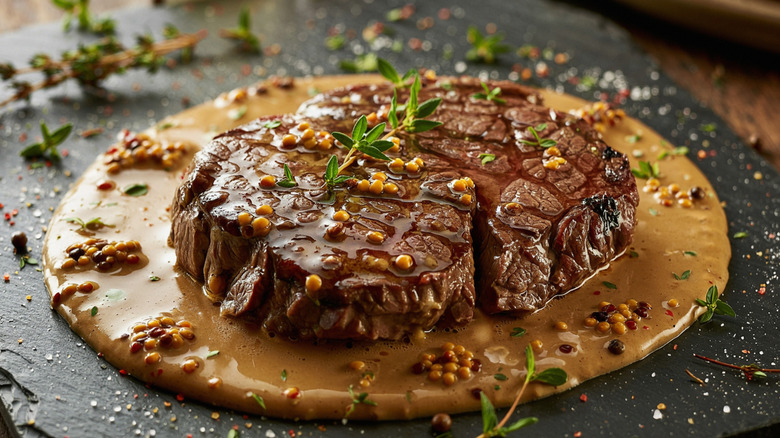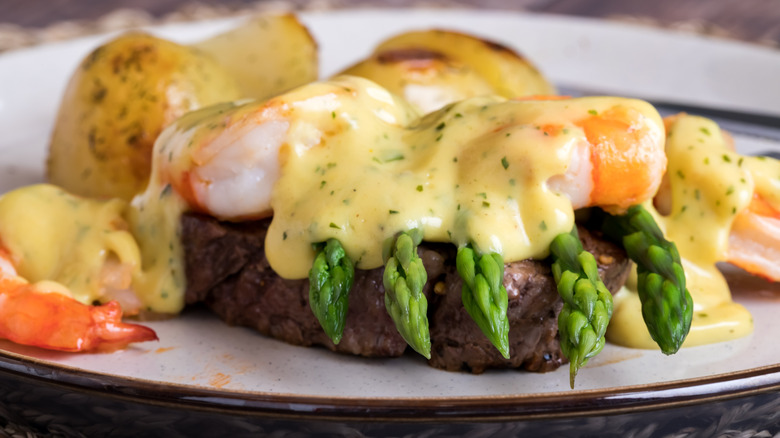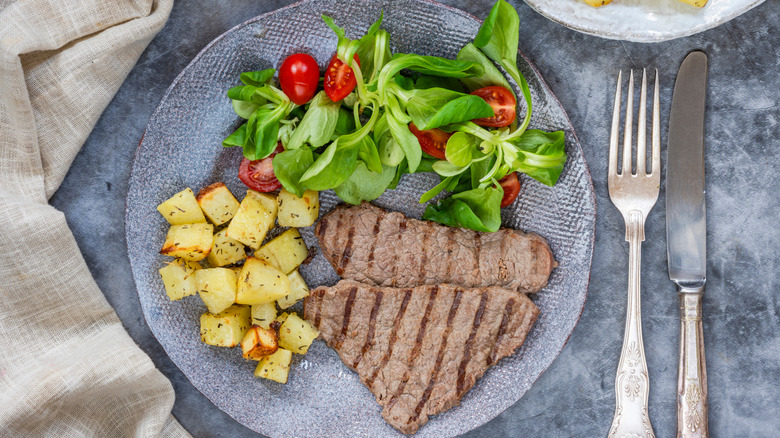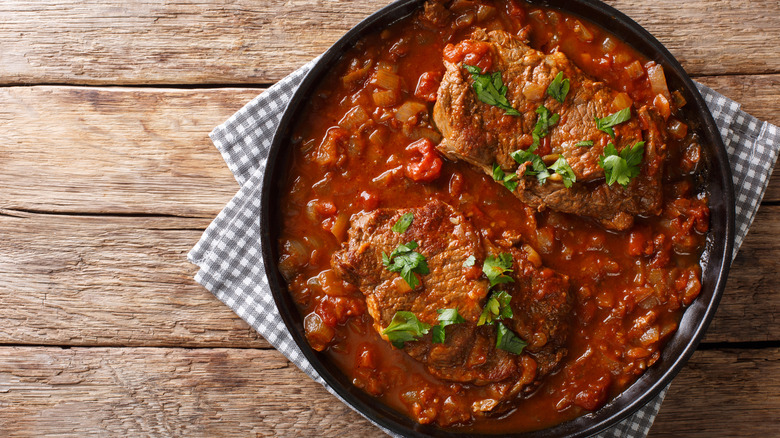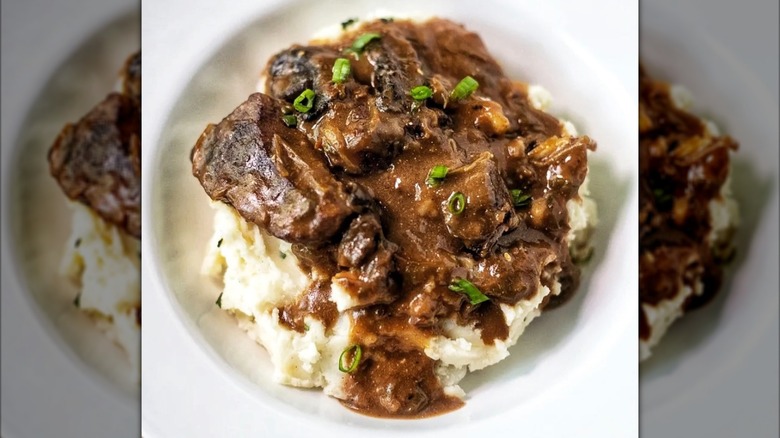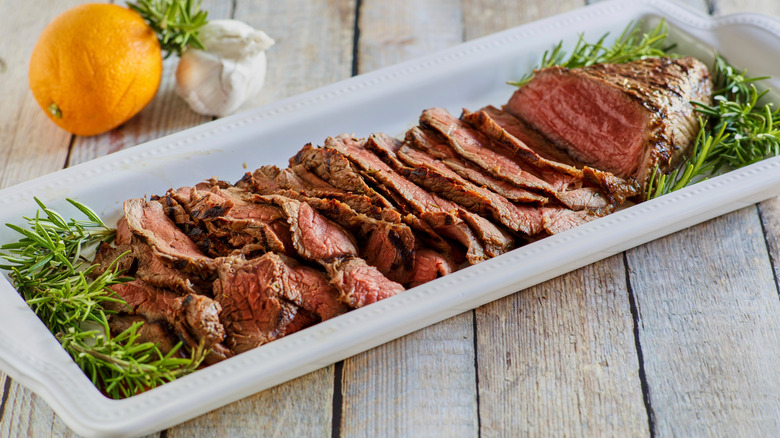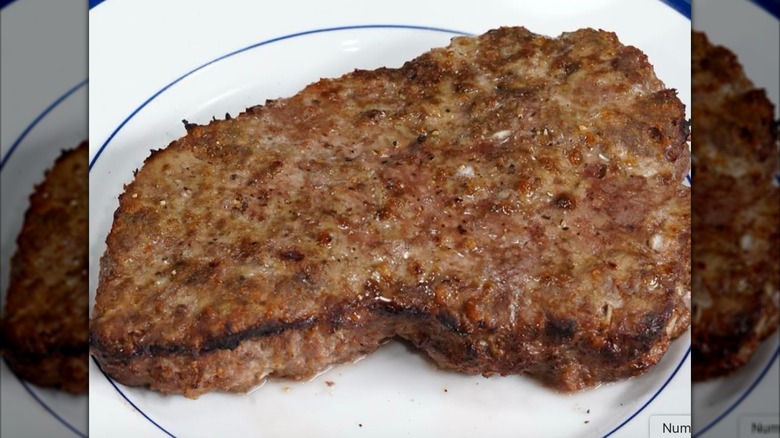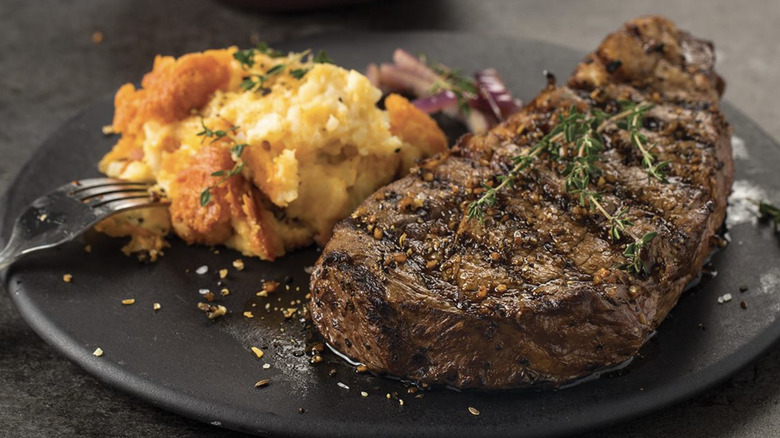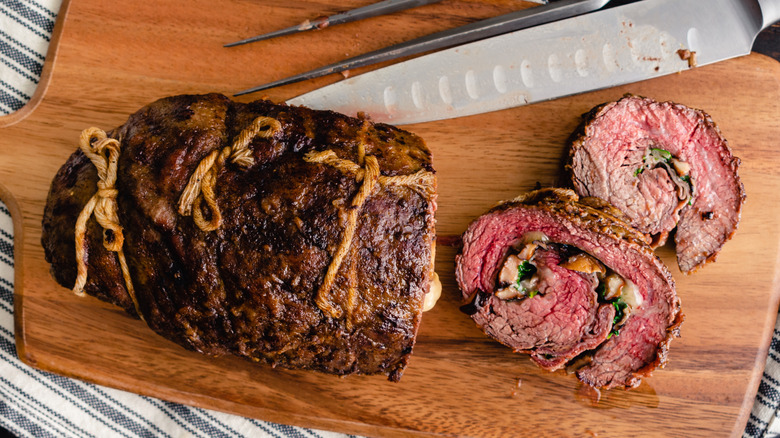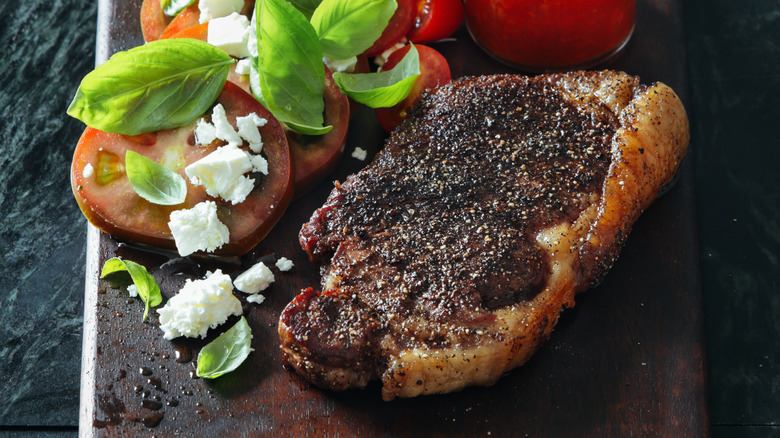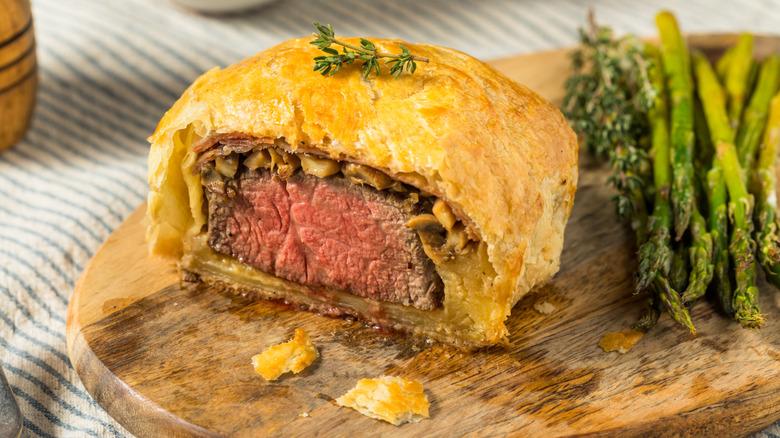Old-School Steak Dishes Restaurants Don't Put On Menus Anymore
We may receive a commission on purchases made from links.
Culinary trends evolve over time due to changing taste preferences, economics, and the availability of ingredients — and steak is no exception. Some vintage dishes that once dominated the menus of restaurants and diners are no longer in vogue, disappearing from mainstream dining in favor of more popular cuts and preparation styles.
With the spotlight shifting away from more budget-friendly cuts of beef and longer preparation times, many old-school recipes have faded into obscurity. Once beloved recipes that relied on braising, smothering, or pounding tough cuts of beef have been overshadowed by premium steakhouse favorites like ribeyes, filets, and New York strips — all of which require less preparation and appeal to today's sophisticated diners who value meat quality. As such, it's no surprise that many retro steak recipes are rarely seen outside family homes, where they are passed down as part of culinary heritage.
Ready to find out more about old-school steak dishes that have disappeared from most restaurant menus? Take a look at our roundup of classic steak dishes that once defined comfort food.
Steak Diane
Steak Diane focuses more on the dressing than the cut of beef, although it's often made with tenderloin medallions or filet mignon. While there is no set recipe for the dish, most versions include a pan-seared tender cut and a rich, nuanced sauce. Once the steak is removed from heat, the pan is deglazed with brandy or Cognac, which is ignited in the pan. The sauce is then finished with stock, cream, and pepper.
Said to be named after the Greco-Roman goddess of the hunt, steak Diane is sometimes compared to French steak au poivre. Despite this resemblance, it's unclear where the recipe first originated. We do know, however, that steak Diane became popular in New York in the 1950s and '60s, where it was enjoyed in upscale restaurants like The Colony, which was a popular gathering spot for the rich and famous.
In its heyday, steak Diane was typically associated with tableside flambéing at fine dining establishments. The steak would be wheeled out on a rolling cart and dramatically set alight in front of the mesmerized diners. Jean Anderson described this showstopping performance in her "American Century Cookbook: The Most Popular Recipes of the 20th Century" (via Lobel's Culinary Club): "The beef, sizzling in a large copper pan with brandy flaming and cause bubbling, makes a wonderful show reminiscent of the days when Humphrey Bogart and friends would bound in at midnight following the newest opening on Broadway."
Steak Oscar
Perfect for those who enjoy both steak and seafood, steak Oscar is a "surf and turf" classic that many diners would no doubt love to see return to steakhouse menus. Unlike other steaks — which are served plain or with a sauce — steak Oscar comes topped with lobster or lump crab meat (and is also sometimes served with shrimp).
While there are no hard and fast rules here, steak Oscar is usually made with filet mignon. The beef can be grilled, broiled, or pan-seared, but is traditionally served rare or medium-rare. Aside from shellfish, steak Oscar usually comes with steamed asparagus spears and creamy homemade béarnaise sauce.
Unlike many other culinary creations, which lack a clear backstory, the origins of steak Oscar are more or less clear-cut. The history of the dish can be traced back to 1897, when it was created for King Oscar II of Sweden. According to lore, the king was a big fan of veal and crab. Eager to please him, a chef combined the ingredients — throwing béarnaise sauce and asparagus into the mix — to suit the ruler's refined tastes. Over time, the dish was adapted to suit more modern tastes, with veal eventually being replaced with cuts of beef.
Minute steak
While affordable and convenient, minute steaks have lost their popularity for a very good reason: They are just not that good. True to their name, minute steaks don't take very long to prepare due to their thinness — frequently just a quarter-inch. All it takes is a minute or two in the frying pan.
Normally sourced from tougher cuts like the rump, strip, or sirloin, minute steaks lack the marbling that makes other beef cuts juicy and tender. This is why the quick cooking time is essential to prevent them from becoming overly chewy. Nevertheless, the final result can be underwhelming, especially for those who are used to more premium cuts of beef.
Minute steaks are sometimes confused with cube steaks, but they are in fact different. Cube steaks are almost always made with very tough cuts of beef — such as top or bottom round — that need to be tenderized with a mallet or a machine. This means that cube steaks can appear textured or pockmarked across their surface. The mechanical tenderization process also makes cube steaks mushier in texture than minute steaks. As such, unlike minute steaks, cube steaks are usually not eaten on their own. Instead, they are used in dishes like tacos and country-fried or chicken-fried steak.
Salisbury steak
Unlike traditional steaks cut from whole cow muscles, Salisbury steak is made from ground beef mixed with binders like breadcrumbs, eggs, seasoning, and flour. This means that the final dish is more like a burger patty or meatloaf than an actual steak. Popularized by frozen TV dinners, Salisbury steak was once a go-to comfort food in countless American households, only to fade from the limelight as tastes shifted towards fresher, less processed meal options.
Salisbury steak has an interesting history, originating in the 19th century as a health food promoted by Dr. James H. Salisbury. Realizing the extent of gastrointestinal issues suffered by soldiers during the Civil War, Salisbury developed a diet that revolved around chopped-up meat or "muscle pulp of beef," as he referred to it. While the science behind the recipe is questionable, it provided the basis for what would eventually become Salisbury steak.
The good doctor wrote about the predecessor of Salisbury steak in his 1888 book, "The Relation of Alimentation and Disease," (via Eat Flavorly) recommending, "Eat the muscle pulp of lean beef made into cakes and broiled. This pulp should be as free as possible from connective or glue tissue, fat and cartilage." In 1904, the recipe appeared in the "Cookbook of the United States Navy" with added breadcrumbs, onions, and gravy — establishing the basis for modern Salisbury steak.
Swiss steak
Despite its name, Swiss steak is not from Switzerland. Instead, it's a classic American comfort food that rose to popularity in the mid-20th century when it was promoted by Reynolds. The company, which produced Reynolds Wrap Aluminum, started advertising the recipe in the 1940s, highlighting how easy the aluminum foil made kitchen clean-ups — a selling point that resonated with busy housewives at the time.
So why such an evocative name? Rather than referencing its origin, the name "Swiss steak" refers to the cut's method of preparation. The dish is made from tough cuts of beef — such as bottom round or chuck — that have been tenderized by pounding or using a mechanical meat tenderizer in a process known as "swissing." This step helps to break down the meat's connective tissue, making it easier to chew.
Once the meat is tenderized, it's dredged in a mixture of flour, paprika, granulated garlic, salt, and pepper. The floured beef is then browned in a hot skillet with a little oil before being set aside. Other ingredients, like onions and carrots, are sautéed in the same pan. Finally, the recipe is finished with stock, tomato sauce, and a splash of Worcestershire sauce. Swiss steak is then cooked in the oven for two to three hours until the meat is fork-tender and the other ingredients have thickened into a gravy.
Smothered steak
Unlike grilled or seared steaks, smothered steak is braised low and slow. Normally made with tougher and more affordable cuts of beef like round, the dish relies on time and moisture for its texture and flavor. The low and slow method of cooking breaks down the connective tissue in the meat while infusing it with savory flavors.
Some of the commonly used ingredients in the sauce include beef broth, onions, mushrooms, red wine, and seasoning. Not only does this gravy transform a chewy cut of beef into a fork-tender creation, but it also makes a great accompaniment to side dishes like mashed potatoes, rice, or grits.
Smothered steak is a Southern classic that blends three culinary traditions — Cajun, Creole, and African American soul food. While each family recipe for smothered recipe may be slightly different, the dish relies on the Louisiana-style technique of tenderizing meat and vegetables by "smothering" — or slow cooking — them in a seasoned sauce and their own juices.
London broil
The London broil steak preparation method is ideal for transforming tough and lean cuts of beef into tender bites fit for any family dinner table. While London broil was originally made with flank steak, home chefs have since started applying the cooking technique to other inexpensive cuts of beef, such as top round or top sirloin.
Since the cuts of steak used for London broil are tough, they are first marinated to break down their connective tissue. While marinade recipes may vary, as a rule of thumb, the beef is soaked in the marinade for between two and three hours for each inch of meat. Next, the steak is broiled or grilled on high heat, stopping at medium doneness — anything more than this is likely to make it tough and chewy. If you are using a meat thermometer, be sure not to let the internal temperature of the meat rise above 135 degrees Fahrenheit. After the steak rests for a few minutes, cut the meat against the grain to shorten its muscle fibers and maximize tenderness.
Contrary to what the name suggests, London broil is an American creation. The recipe for the dish first appeared in print in the 1930s and may have ties to Philadelphia, although the details about its exact history are murky. Whatever its origins, London broil was likely a fancy way of promoting less tender cuts of beef in the past.
Emergency steak
Emergency steak was a product of wartime necessity. As staples like sugar, coffee, and butter started disappearing from grocery store shelves during World War II, the government was forced to implement rationing. It wasn't long before home chefs started getting creative in the kitchen to make any difficult-to-obtain products go further.
Emergency steak is made from ground beef, milk, seasoning, and dry breading shaped into a thick patty that resembles a prime quality steak. Apparently, many chose to mold the beefy concoction into the shape of a T-bone to give it the illusion of a high-end cut. Interestingly, a recipe for Emergency steak in a Betty Crocker cookbook from the 1950s called for a strip of carrot to act as a makeshift T-bone. Not surprisingly, it also included Wheaties as a substitute for bread crumbs — General Mills owns both Wheaties and Betty Crocker. While Emergency steak probably got the job done, filling empty bellies, it's clear to see why the dish waned in popularity, as better quality cuts became more accessible to the average household.
Delmonico steak
Unlike many other steak types whose beginnings are open for debate, the history of Delmonico steak is relatively easy to trace. The dish originated at Delmonico's, the first upscale steakhouse in the U.S. Opened in 1837 in New York City, the restaurant is said to have been the first restaurant in the country where diners could order from a menu. It also featured an impressive cellar that could house 1,000 bottles of wine.
Created by Chef Alessandro Filippini shortly after the restaurant first opened, Delmonico steak means different things to different people. According to one theory, Delmonico steak refers to thick, high-quality cuts of beef that are both tender and juicy. The cuts typically come from the rib or the short loin of a cow. Nevertheless, there is no agreed-upon cut that defines a Delmonico steak, which leaves plenty of room for interpretation — some butchers have gone as far as giving the label to chuck eye steaks.
Delmonico's is still operating on the corner of Beaver, William, and South William Streets, where it opened in the 19th century. Keeping with tradition, the restaurant still serves its signature Delmonico steak in the form of a boneless ribeye. Whether this is the exact same recipe that the restaurant served so many years ago is anyone's guess.
Stuffed flank steak
Most steaks are seasoned and then grilled or seared. Stuffed flank steaks are much more elaborate, allowing for plenty of culinary experimentation. Sometimes also referred to as roulade, stuffed flank steaks are made by taking a flat, lean cut of beef — like flank steak — and rolling it around a savory filling. Sourced from the lower stomach part of a cow, flank steak contains a lot of muscle fibers, making it tough if not prepared correctly.
Stuffed flank steaks lend themselves well to slow and low cooking, a process that both tenderizes the meat and allows the flavors of the stuffing to meld with the beef. For best results, butterfly the beef to create a wider surface for the filling. You can then use a mallet to tenderize the meat, although this is optional.
While the stuffing recipes vary, some options include a mixture of cheese, prosciutto, and salami, as well as mushroom or tomato gravy. Once the filling is evenly spread across the butterflied beef, roll the steak into a log, securing it with toothpicks, skewers, or string.
Steak au poivre
While steak au poivre can still be found on the menus of some classic French restaurants in the U.S., you would be hard-pressed to find it at a typical American steakhouse. However, this wasn't always the case – old-school steak au poivre was once popular at fine dining establishments across the country. In fact, the first published recipe for the French dish in the U.S. appeared in Julia Child's 1961 cookbook "Mastering the Art of French Cooking."
Aside from beef (traditionally filet mignon), the centerpiece of steak au poivre is crushed peppercorns, which are pressed into the raw meat. After it's sautéed, the steak is set aside while Cognac is added to the pan. The alcohol is ignited in a quick flambé, and then cream is added to the pan to create a rich, peppery steak sauce.
Interestingly, Child felt that there used to be too much flambéing going on at restaurants that had the dish on the menu, writing, "Steak au poivre can be very good when it is not so buried in pepper and doused with flaming brandy that the flavor of the meat is utterly disguised. In fact, we do not care at all for flaming brandy with this dish; it is too reminiscent of restaurant show-off cooking for tourists. And the alcohol taste, as it is not boiled off completely, remains in the brandy, spoiling the taste of the meat" (via Four Pounds Flour).
Beef Wellington
Beef Wellington (a dish that's tricky to make at home) experienced the height of its popularity in the 1950s and '60s. The pastry and beef roll is said to have been a favorite of Presidents John F. Kennedy and Richard Nixon. The dish also appeared in Julia Child's 1961 classic "Mastering the Art of French Cooking," and was featured on her cooking show in 1965.
For those unfamiliar with the dish, beef Wellington is made by coating a seared beef tenderloin with ingredients like mustard, mushrooms, and prosciutto. The meat is then rolled into a log and enveloped in puff pastry before being baked in the oven.
While nobody really knows how beef Wellington got its start, the dish is often linked to Arthur Wellesley, First Duke of Wellington. The military figure is best known for winning the Battle of Waterloo against Napoleon Bonaparte — a feat that not only sealed his legacy in history but could have also influenced the naming of this dish. While beef Wellington is still relatively popular in Britain, it's rarely seen on restaurant menus in the U.S., with one notable exception. The television personality and chef, Gordon Ramsay, offers the "Beef Wellington Experience" at some of his restaurants, where the crispy dish is served alongside a passion fruit cocktail and a sharing dessert platter. The dish is also on the menu at Gordon Ramsay Pub & Grill at Caesars Atlantic City.

